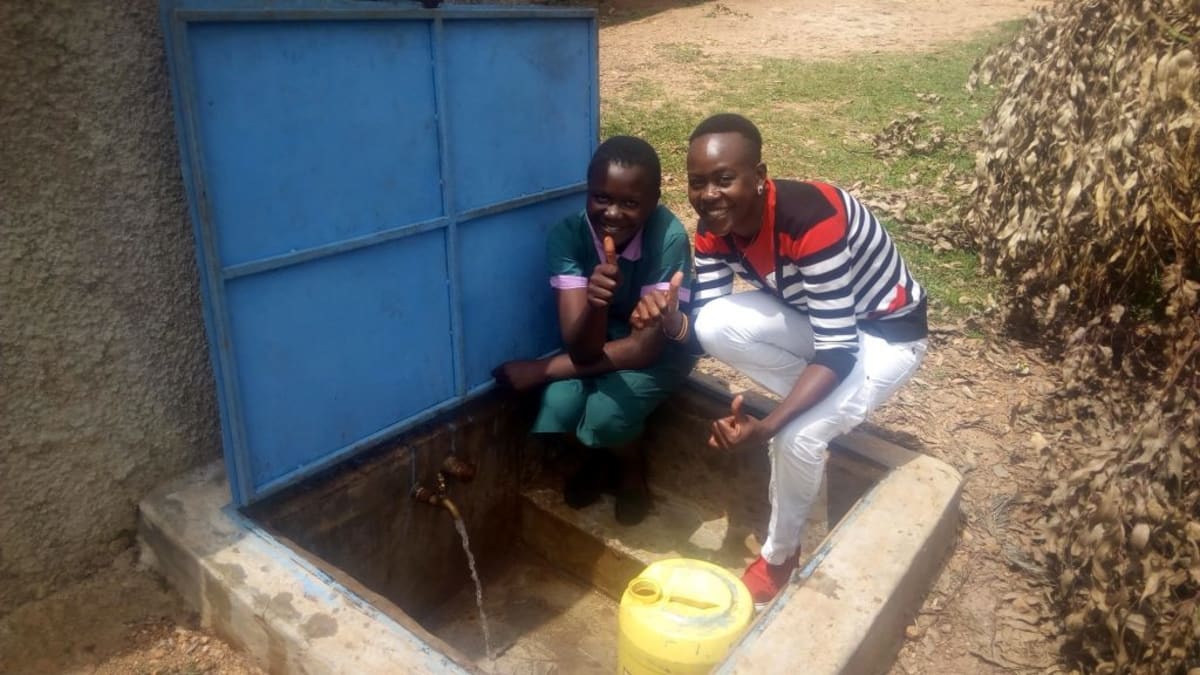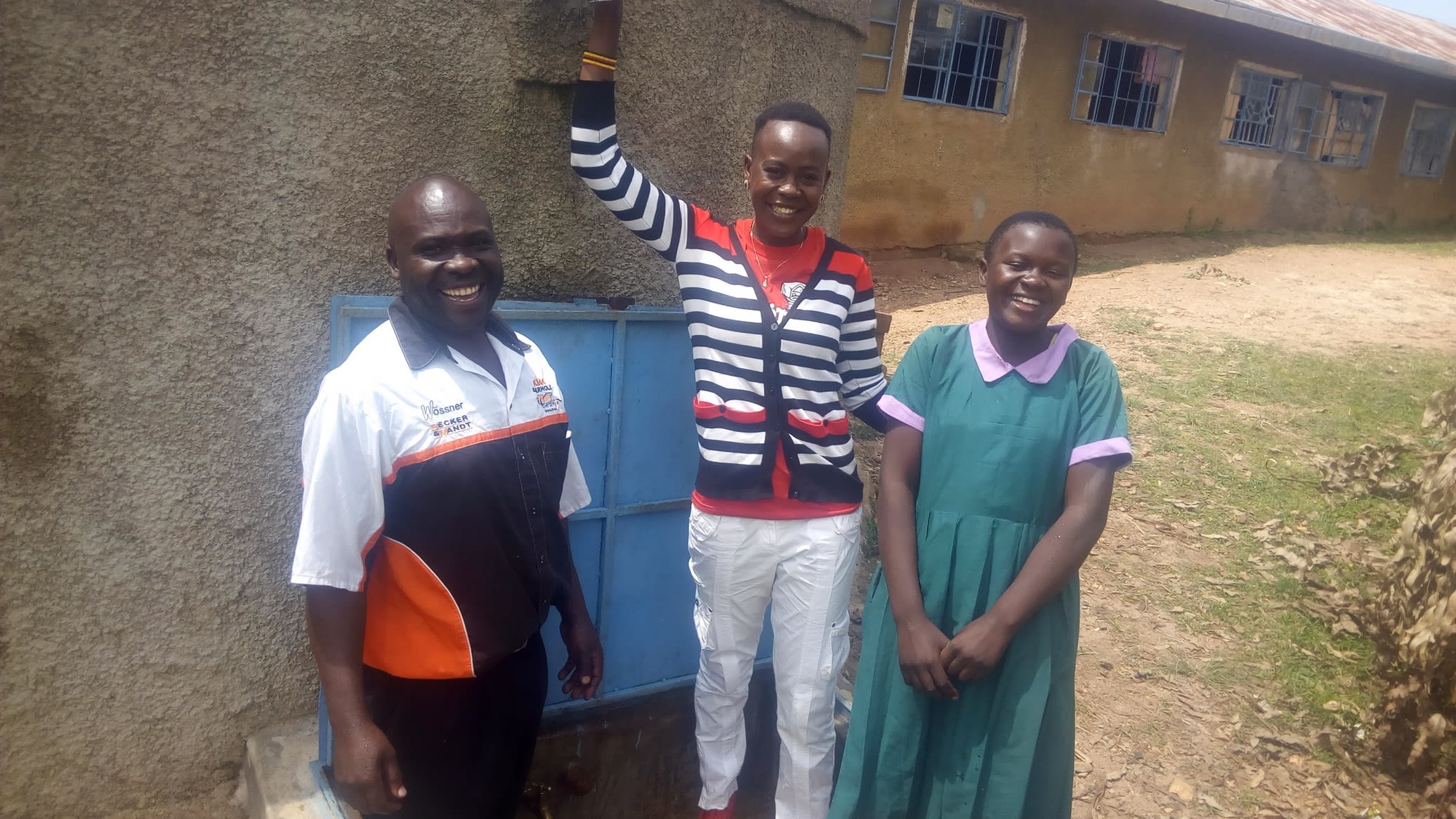This project is a part of our shared program with Western Water And Sanitation Forum (WEWASAFO). Our team is pleased to directly share the below report (edited for clarity, as needed).
Welcome to the School
Our first trip to visit this school seemed to never end. We found out the school is located in a very rural place, and our team had to keep stopping for directions. Every person was busy on their farm either picking tea, or digging, or constructing bricks. Some idlers are seen along the roads, while a good number of women move along the rough road carrying water containers of different sizes. The terrain is rugged, and each person seemed to give more and more ambiguous directions that got us lost among the rocks and hills. Turns out we had been wandering around in a lush area, moving back and forth by the hidden school gate! The school's title was worn off the wall, and we couldn't see it. Our first sight was of girls lined up in front of a plastic tank; but all of a sudden, three of them left and rushed towards the lower part of the school compound with jerrycans in their hands. They ran past the poetry club that was preparing for the regional competition at Busia, and disappeared into thin air - only to return carrying water in those jerrycans. Mr. Madafu, the headteacher explains that the 5,000-liter plastic tank they have cannot serve all the children. Therefore, classes are interrupted every day for pupils to rush to Wambasu Spring. Since it's a community water source, all community members get to fetch water before the pupils, which wastes a lot of their study time.
This is the only school in the region that has put together a successful food program for all of its students. Every child must give eight kilograms of maize and six kilograms of beans at the beginning of each term. To ease any burden this would place on parents, each class from grades four to eight has been given a piece of land where they plant their own maize and beans every season! The harvest is divided equally among the students. This has given children a spirit of competition as they compete by planting, cultivating and harvesting. Every class wants to beat the other with their agricultural prowess!
Boys rush to get fruits from a tree to dull their hunger pangs during class break, since most of them do not get breakfast at home. Some of the boys put a few of the fruits on plates and give them to the girls, who are not allowed to climb trees according to Maragoli culture. Fruits are being eaten even before washing hands - no wonder diarrheal diseases are common in this school. Girls are removed from class to assist in cooking and washing utensils. Every child goes home by 4:30pm as required by the government, so that they have enough time to help parents with house chores and to do their homework.
Water Situation
A 5,000-liter plastic water tank was donated to the school, but its much too small for 524 students. Even if the tank is full of rainwater, it barely provides for two days of drinking, cooking, irrigating, cleaning of latrines and mopping of classrooms. When water is finished off, every child from class four to eight is sent to get water from a spring in the community, where they have to line up as they wait to fetch water. Kelly Eboso believes this is one explanation for why she and her peers don't score excellent marks on their exams.
At least two students are out with waterborne diseases each school day. Though the community spring is protected and should be yielding clean water, it is likely that water is being mishandled and stored improperly before it's consumed.
Sanitation Situation
Boys only have four latrines available, which makes for long lines during class breaks. Many of these young students can't bear the long wait to relieve themselves, and look for a quiet place elsewhere. The stench resulting from gross overuse of these latrines is unbearable. The facilities are also as old as the school itself (1956). A boy almost fell through the floor once, but managed to pull himself out of the pit because he had caught the door frame. After this incident, the door was boarded up. Girls have eight latrines, but these are filthy. Once of them is even missing a door, so none of the girls dare to use it.
There are no hand-washing stations for students or teachers to wash their hands.
The school cook mentioned that diarrheal diseases are the most common and most dangerous consequences of poor sanitation at Chandolo Primary School. She believes that if they get a 50,000-liter rainwater catchment tank and six new latrines, these complications will be a thing of the past.
Plans: Hygiene and Sanitation Training and Hand-Washing Stations
Training will be held for two days. The facilitator will use PHAST (participatory hygiene and sanitation transformation), ABCD (asset-based community development), CTC (child to child), lectures, group discussions, and handouts to teach health topics and ways to promote good practices within the school. The CTC method will prepare students to lead other students into healthy habits, as well as kickstart a CTC club for the school. This CTC club will oversee the new facilities, such as hand-washing stations, and make sure they are kept clean and in working condition. The two hand-washing stations will be delivered to the school, and the club will fill them with water on a daily basis and make sure there is always a cleaning agent such as soap or ash.
Plans: VIP Latrines
Two triple-door latrines will be constructed with local materials that the school will help gather. Three doors will serve the girls while the other three serve the boys. And with a new source of water on school grounds, students and staff should have enough to keep these new latrines clean.
Plans: Rainwater Catchment Tank
A 50,000-liter rainwater catchment tank will help alleviate the water crisis at this school. The school will also help gather the needed materials such as sand, rocks, and water for mixing cement. Once finished, this tank can begin catching rainfall that will be used by the school’s students and staff. With proper management of this huge tank, students will no longer have to carry heavy containers of water to school anymore.
We and the school strongly believe that with this assistance, standards will significantly improve. These higher standards will translate to better academic performance!

 Rainwater Catchment
Rainwater Catchment
 Rehabilitation Project
Rehabilitation Project


































